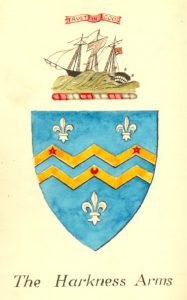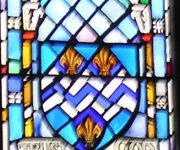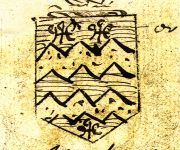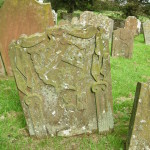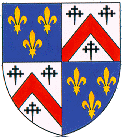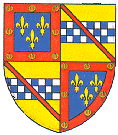(Extract of Article Published in the Scottish Genealogist 2005)
Painting a family history requires a broad palette. When I set out to explore the history of the ancient Scottish family of Harkness I was determined to explore as many potential clues and sources of information as possible. Heraldry was one area that, although baffling and confusing, provided fascinating material and colourful insights.
The Benefactor
My foray started with the Scottish ‘Public Register of All Arms and Bearings’. According to Sir James Balfour Paul, former Lord Lyon King of Arms “No persons of Scottish descent whose arms are not registered in it have a right to armorial bearings unless they can prove that they represent families whose arms are known to have been in existence previous to 1672”. In 1672 the Register was established because of either the loss through fire or neglect of records relating to Scottish arms. The only Harkness arms in the register was dated December 1930. The circumstance of the grant of these arms is an interesting story in itself. Briefly they were granted at the petition of the University of St. Andrews so that the university could show its gratitude to a benefactor, Edward Harkness of New York. Edward Harkness was a co-founder of Esso along with Rockefeller. He was a major patron of both Yale and Harvard Universities and, after striking up a friendship with the Principal of St. Andrews, Sir James Irvine, he donated funds towards a scholarship scheme; the building of a residence hall; and the restoration of the University’s 15th century chapel, St. Salvator’s. The generosity of Edward Harkness inspired the Principal to rank him “among our ‘pious founders and benefactors’ taking a place with the good Bishop Kennedy, the Archbishops, the Cardinal, The King of Scots and Queen Mary who gave us our heritage”.[i] After successfully petitioning for the Harkness arms, they were incorporated into a stain glass window behind the altar of the renovated chapel as an unsolicited gesture of thanks to Edward Harkness.
Unfortunately there does not appear to be any record of where these arms were obtained. The Lord Lyon could not grant Edward Harkness the arms as he was an American so they were granted in the name of his ancestor William Harkness of Dumfriesshire “who went to America circa 1710”. The Lyon office has no record of the source and neither has the University. Lack of resources prevented me exploring the Edward Harkness archives in New York. Burke’s ‘Encyclopaedia of Arms’ does, however, include a description of Harkness Arms that would appear to be similar to those adopted by Edward Harkness – “Azure, 2 bars dancette Or, the first charged with 2 mullets and the last with a crescent Gules, all between 3 Fleurs-de-lis, Argent” complete with a crest of a ship in distress and the motto “Trust in God”. Again no source is provided. It has been suggested that because the arms do not appear in the Register they probably pre-date 1672. I do not know if that could be argued with any confidence.
The Deuchar Collection
My search then took me to the National Library of Scotland where I found a manuscript by David Deuchar an eighteenth century Edinburgh seal engraver – “A collection of Arms many of which from the original patents granted before the burning of the Old Records together with others lately recorded in the Lyon Office and many coats of arms which are rare to be met with in any books published on Heraldry both Scots and English, Irish and French. By David Deuchar, Seal Engraver, Edinburgh. Begun about 1790 – finished 1807”. Included in the book was a plate showing a rough sketch of “Harkneys Arms” very similar to those mentioned above complete with three fleur de lis, crest and motto.
A book by Alexander Deuchar – “British Crests …. “ published Edinburgh 1817 – contained a Harkness crest again similar to those mentioned earlier. The Deuchars would make an interesting story by themselves. Suffice to say they were major collectors of Scottish records and memorabilia; David Deuchar is reputed to have given lessons to Raeburn and was engraver to the Prince of Wales. Unfortunately their collection was sold off in 1848 and only a few books, along with the sale catalogue, remain in the National Library of Scotland. There is no record of where the bulk of this remarkable collection went.
The Deuchars have been accused of using artistic licence and imagination to please their clients. Clearly it was possible that David Deuchar may have devised the crest and motto and I thought at first that the Harkness arms produced by him may have come through a mistaken association of the names Harkness and Harcarse or Harkas. These names are often confused although my wider research shows clearly that they were quite distinct and separate in their origins. With the kind assistance of the late Robert Mitchell of the Heraldry Society of Scotland it was established that there were Harkas arms that included three fleurs de lis, dating from 1300. Spellings of names vary in the records but it was not until the 15th century in the French Armorial de Berry that a chevron was found added to the arms – “Ceulx de Herques – Argent, a chevron between three fleurs-de-lis Sable”. The arms portrayed in the Armorial show black fleur de lis and chevron on a white background. J Storer Clouston made a detailed study of the Armorial de Berry which he published in the Proceedings of the Society of Antiquaries of Scotland.[ii] He made the point that there was a tendency to reverse the colours and specifically cited Harcarse as an example. The Herques arms were not associated with ‘Harcarse’ in the original Armorial. The association was made at a later date, probably by Stoddart who reproduced the Armorial. Storer Clouston also makes the point that the Armorial “frequently confounds black and blue. One must, therefore, always make allowance for this”. It is perfectly possible that the arms shown in the Armorial de Berry are consistent with later Harkness arms – three gold fleur de lis on an azure background. Although the author of the Armorial is believed to have travelled personally to Scotland in the 15th century to research the arms, it is interesting that Berry is an area in France historically associated with the Scots. It was the main area where 15th and 16th century Scots established themselves and their descendants live today.
Graves and Fleurs
The matter might have rested there had I not come across an article in the Proceedings of the Dumfries and Galloway Natural History and Antiquarian Society on ‘Armorial Bearings’ by J. Bell Irving.[iii] This thoroughly researched article included two entries under Harkness. The first was dated 1765 –“George Harkness in Crowsknow. Kirkbankhead [graveyard] – a chevron between 3 fleur de lys”. The second dated 1848 – “Richard Harkness, died Marchhill. St. Mary’s, Dumfries – 2 pairs of bars gemelle dancette between 3 small fleur de lys, between the upper pair two mullets, and between the lower pair a crescent”.
The location of Kirkbankhead proved allusive until I found mention of the gravestone in a reference to the survey of graveyards in Dumfriesshire by Gilchrist and Shannon.[iv] It is in fact the Tower of Sark Graveyard, Half Morton Parish in the heart of the Debatable Land – reputed resting place of ‘Kinmont Willie’ Armstrong.
The gravestone is that of George Harkness born around 1702, died 1765 and on the back are clearly carved three fleurs de lis with a chevron.[v] Far from solving the mystery of where the Harkness arms could have originated, this only served to deepen it. Deuchar could not have invented arms that were linked to a Harkness a hundred years or more earlier. Crowsknowe, and many other Dumfriesshire and Roxburghshire farms historically linked to Harkness tenants, is a Buccleuch Estate farm – formerly of the Douglases.
Although clearly taking the Harkness association with these arms back far earlier than supposed, I still did not have the answer to its origin. It was only by bringing together other aspects of my research that a likely explanation began to emerge.
The Auld Alliance
Firstly there was the Harkness connection to the south west of Scotland from the 15th century onwards. Not only to that area but also as tenants and supporters of the Douglas and later Scott of Buccleuch families and estates. Secondly the association with this area, and particularly the Douglas family and their associates, with support for the French kings from the 15th century onwards. Thirdly there was the apparent occurrence of the name Harkness in muster rolls of the elite bodyguard of the French kings, the Garde Ecossaise. Last, and most significantly, that the French royal coat of arms is three gold fleur de lis on an azure background – the basis of the Harkness arms.
It would not be appropriate for me to reiterate the history of the ‘Auld Alliance’.
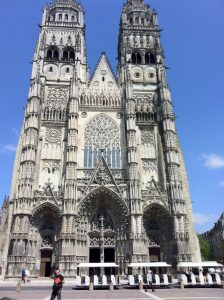
Saint Gatian Cathedral Tours. Archibald Douglas, 4th Earl of Douglas, Duke of Touraine, buried with his son, Sir James Douglas in the Choir
There are many good accounts of the association between Scotland and France, some quite recent and well researched. ‘An Antidote to the English –
the Auld Alliance, 1295 – 1560’ by Norman Macdougall of St. Andrews University[vi] is an up to date, very readable and well researched account with a good bibliography. Briefly the Alliance was born out of Scotland and France’s mutual difficulties with England’s Edward I in 1295. The peak of Scotland’s commitment was probably during the early 15th century, prior to and alongside Joan of Arc, when France’s very survival was a stake. More than 10,000 Scots were in France at one time fighting against the
English in the French cause, most of these from the south of Scotland. Indeed there could not have been many men of fighting age from south west Scotland who were not in France at one time. Heavily involved in the French campaigns were the Douglas family. Without precedent, Archibald the fourth earl of Douglas was granted the dukedom of Touraine by Charles VII in gratitude for his recruiting efforts and allowed to quarter his arms with the French royal arms, three fleur de lis on an azure background. Similarly around this time John Stewart, Duke of Darnley, was given French titles and properties as were the earl of Buchan, Thomas Seton and Hugh Kennedy. Surviving arms show the French arms quartered with the arms of Stewart and Kennedy. [vii]
The French king was so impressed with the loyalty of the Scots and their fighting qualities that he established the Garde Ecossaise as his personal bodyguard, a relationship which was to last into the 19th century. Again the history of this unique Scottish arm of the French military is well recorded. The relevance for my research is two fold.
Firstly from surviving lists of the members of its various units there are the following:-
1450 – hommes d’armes de la Garde du Corps ……… Pierre de Hartonye
1453 – archiers de la garde …………………………… Jehan Hacquin
1455 – archiers sous P. Folcart ………………………. Jehan Harquin
1457 – archiers de la garde …………………………… Jehan Hasquin
1460 – archiers de la dicte garde ……………………… Jehan Harquin
1469 – hommes d’armes le dit Robert Conygham ……. Thomas Harques [viii]
Harkness is a difficult enough name to live with in the English-speaking world. Physiologically, I have learned, its structure makes it difficult to pronounce and there is always a tendency for people to try and change it to a more user-friendly form, invoking “the principle of ease, or minimization of effort”.[ix] My own experience regularly is that shop assistants, hotel receptionists, call centre employees, etc., produce Harkins, Harkess, Harkiness and Hartness amongst many others. Travels in France generate even greater variety. Some of the other names in the muster rolls of the Garde illustrate the problem.
Actuisson – Aitchison
Ouillesson – Wilson
Quhafurd – Crawford
Aliberton – Haliburton
Tourneboulle – Turnbull
The second point is perhaps the key to how the French royal arms came to be on a gravestone in Dumfriesshire. The motto of the Garde Ecossaise was ‘Omni Modo Fidelis’ – quoted in a speech by General Charles de Gaulle in Edinburgh in 1942 when he gave credit to the steadfastness of the 51st Highland Division at Dunkirk for inspiring him to fight on after the fall of France in 1940.[x] Successive French kings showed their appreciation to their Scots bodyguard for their loyalty in a variety of ways in addition to titles and property. For instance Louis XII granted rights of naturalisation to all Scots in France so that they could make wills leaving property to their heirs in France. Notably, from the point of view of my research, Henry IV, and probably other French monarchs, granted members of the royal bodyguard, the Garde Ecossaise, the right to bear the French royal arms.[xi]
Conclusion
The further one goes back in history the fewer the facts and the greater the shortage of information on which to base firm conclusions. Of necessity, many history books contain speculation, conjecture and assumptions based on the best evidence available. The aim should be to make it clear what is speculation and to provide the facts that form the basis for assumptions so that others may draw their own conclusions.
I do not know that a Harkness – tenant or follower of the Douglases from the south west of Scotland – travelled to France in the 15th or 16th century. I do not know that he found his way into the Garde Ecossaise and for whatever reason earned the right to bear, or perhaps appropriated for himself, the arms of the king of France. However, given the available information, it seems to me a likely conclusion.
Frank Harkness. BA, MSc, FSA Scot.
Additional Information Since Article Published
(1) It seems possible from the dates given above and the similarity of the arms that Richard Harkness, Marchill, Dumfries may have commissioned Deuchar to produce the arms illustrated above.
(2) The second line of the 25th Psalm, a psalm associated with Covenanting martyrs, contains the following:- “Oh my God, I trust in thee”. This may be the inspiration for the motto “Trust in God”.
(3) In 2010, while in New York to attend a family wedding, I visited Harkness House, the home of Edward Harkness in Manhattan. I was with an American Harkness Researcher, Gail Harkness and we were given a full tour of the house which still retains the character of a family home but is the headquarters of the Commonwealth Fund, founded by Anna Harkness, Edward’s mother. The coat of arms obtained for him by St Andrews University along with a portrait of Edward in his St Andrews University honorary doctorate gown, is on display in the former dining room, now the Fund boardroom. Despite a great deal of good will and assistance from the curator nothing more was learned of the origins of the arms.
[i] Letter from James Irvine to Edward Harkness
[ii] J. Storer Clouston. Proceedings of the Society of Antiquaries of Scotland. Pages 84 – 114. Vol. 72 1937 – 1938.
[iii] Proceedings of the Dumfries and Galloway Natural History and Antiquarian Society (3rd Series Vol. 1 & 2. 1912 – 1914.)
[iv] Memorials of Half-Morton and Morton, Tower of Sark. Gilchrist and Shannon. 1965.
[v] Gilchrist also records in Annandale a number of Carruthers, Montgomery and Brown heraldic carvings similar to that of Harkness. I know of no Carruthers connection with France but Montgomery and Brown/Brun certainly occur in the histories.
[vi] An Antidote to the English – the Auld Alliance, 1295 – 1560. Norman Macdougall. Tuckwell Press, East Linton. 2001
[vii] David Lindsey of the Mount Armorial.
[viii] The Scots Men at Arms and Life Guards in France. Vol.2, pages 15/26 & 160/161. William Forbes-Leith. Pub. Edin. 1822.
[ix] The English language – A Historical Introduction. Charles Barber. Cambridge University Press 1993.
[x] Auld Alliance page 42. Stephen Wood. Edin. 1989.
[xi] The Scots Men at Arms and Life Guards in France. Vol.1, page 10. William Forbes-Leith. Pub. Edin. 1822.

